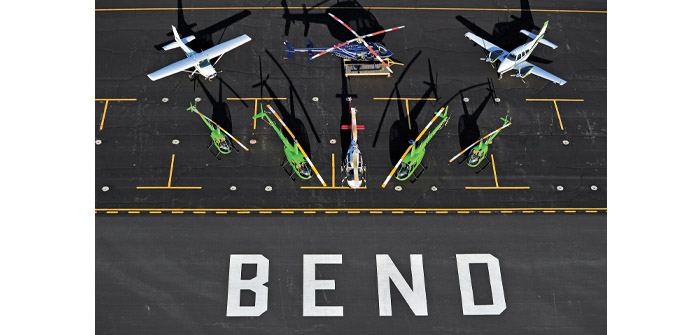(Photo | Courtesy of Leading Edge Flight Academy)
The Leading Edge Flight Academy is a pilot training institution and program based out of the Bend Municipal Airport. For nearly 20 years, they have been training the next generation of plane and helicopter pilots; graduates from their program are literally flying all over the world.
Katharine Ayres is the school’s director of admissions. According to Ayres, “Leading Edge is a part 141 and part 135 certified flight school with the Federal Aviation Administration.”
For context, part 141 means that they are certified to teach new pilots in their programs, and part 135 means they are certified to fly tours and charter flights, which can include a variety of flights, from assisting with forest fire control to flying for private events such as weddings and tours.
“In terms of our educational opportunities, think of us as a college level flight school,” Ayres said. “The FAA goes over and regulates everything we do from our training practices to monitoring our graduation rates. We are as certified as possible.”
Like many educational opportunities in Central Oregon, prospective students can get involved with Leading Edge through COCC, “We are the flight provider for their aviation program,” Ayres said, “many students come in wanting to be airline pilots, search and rescue pilots, and more. We are the first educational building block in that path. We are figuratively and literally teaching students to fly from the ground up.”
The average student at Leading Edge can be difficult to define, as the school is not only connected to COCC, but also to veterans administrations, meaning students are often a mix of 18-22 year olds and veterans aged 45 and older. At the youngest, students must be 16 years old to fly solo and 17 years old in order to receive a private pilot certificate.
However, Ayres clarifies that Leading Edge typically doesn’t work with students who are not ready to make the full time commitment to their pilot training.
Enrolling in the aviation program at COCC is a two year professional pilot training course, signing students up for a 30-40 hour per week commitment. Students in the program take three to four classes based on aviation in some way (aircraft systems, human risk factors, etc…) as well as flight and ground lessons at the Bend airport with Leading Edge.
“With the degree power of the college and the certified flight school power of Leading Edge combined, those students get a two year associates degree and they’ve also worked through a professional flight training through the school,” Ayres said.
Outside of the COCC program, Leading Edge still offers pilot training for a variety of rankings, also known as ratings by the FAA. The flight school offers classes to obtain four levels of FAA certified ratings.
The first rating is the private rating, which is the most basic training at the school. “That is the training every pilot needs to go through,” Ayres said. “Learning to fly and operate the aircraft can be the least demanding part. All of the ground knowledge and language around flight can take more time for plenty of students.”
Next, the instrument rating certifies that the pilot knows how to fly the plane or helicopter using just the technological instruments on the aircraft. After that, students can earn their commercial rating and then move onto the final rating step, the instructor ratings, which come in two steps: certified flight instructor and certified instrument instructor. Those last two ratings are required to become an instructor and teach the classes that provide the first two ratings, private and instrument.
Each rating can take around six months to complete, and the FAA mandates a written test and a final check ride that is both on the ground and in the air to be completed before awarding any ratings.
Across all of these trainings, students at Leading Edge become fully certified to fly commercially, and collect around 250 hours of in-flight experience. However, most professional pilot positions require at least 1500 hours of in-flight time. Leading Edge takes this into account and has a solution for students.
“Similar to a medical residency for newly graduated med students, the graduates of our program, while legally certified, still need to collect more in-flight hours in order to be hirable,” Ayres said. “For any graduates of our full program, we offer an instructor position. This is a way for new pilots to work in the industry and gain the experience they need before jetting off to a new position as a professional pilot for a major employer.”
Ayres said that most instructors reach their 1500 hour mark in anywhere from one-and-a-half to two years. Typically, graduates from Leading Edge do very well in the industry. According to Ayres, the industry is still in the midst of a pilot shortage, caused by a variety of factors. Due to this, and the level of connections that Leading Edge has with both COCC and industry leading employers, graduates from this school are guaranteed an interview at certain employers, while other employers actively seek out graduates from Leading Edge.
While Ayres said that hiring has picked up, she clarified that the level of pilots in the industry likely won’t balance out until 2030, meaning that now is a prime time to start a new career as a pilot.





